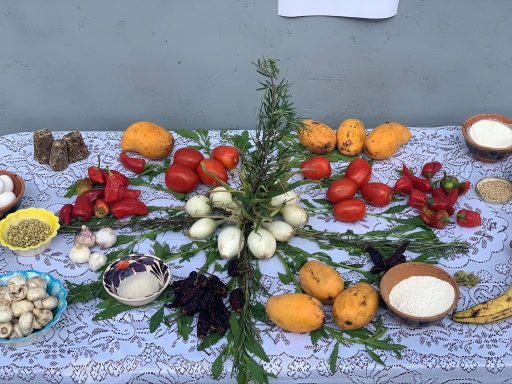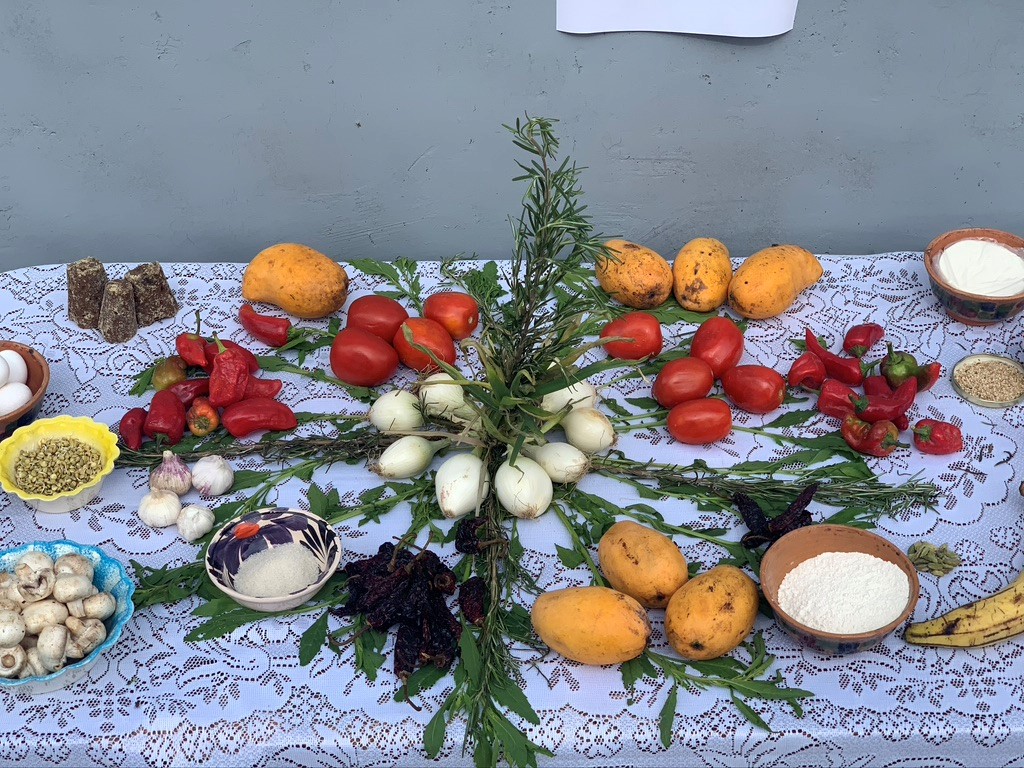
Location
Santo Domingo Tomaltepec, Oaxaca, México

Synopsis and Position
Cocina CoLaboratorio (CoLaboratory Kitchen) is a transdisciplinary project that gathers creatives, farmer communities, scientists and cooks around the kitchen table to exchange knowledge, design and take action towards sustainable food futures. A test ground for ideas that conciliate land restoration, food production and better livelihood in rural and peri urban areas. A collaboration between research institutes from the Autonomous University of Mexico (UNAM), local and international universities, civil organizations, and individuals from different backgrounds.
The project is part of the Food Art Research Network and the Green Art Lab Alliance. Winner of the “Climate Action Challenge” from What Design Can Do 2018, recipient of “Premio William Bullock 2020” for critical museography., and winner of the “Global Challenge 2021” from Architecture-in-Development.
As part of Cocina CoLaboratorio, the Biocultural Living Archives (BLA) initiative was conceived as a mobile and organic community archive parting from the principles of critical museology, social/participatory art, and site-specific social design. The BLA sets up devices for exchange and networking, a window for cultural diversity, collaboration, and participation, within the framework of local food systems.
Objectives and Methods
This platform regards the kitchen as a co-creative space where people are connected through growing, cooking, tasting, sharing, and experimenting. Aspirations and actions are shared and undertaken around the kitchen, mixing world views, knowledge, practices and produce through different activities and programs catered to specific sites and cultures.
The objective of this project through Imagining Futures is to create a methodology with, for, and in the community of Santo Domingo Tomaltepec to strengthen, expand, and perpetuate the Biocultural Living Archives. The resulting “Collective Archivism” toolbox will offer political strategies for territorial defence and to inspire sites of Loma Bonita and Xochimilco. This will be done by integrating four avenues or axes of “collection” that will permeate the practice and analysis of the BLAs: memory, senses, emotions, and movement. By capturing a broader range of human experiences these axes can trigger a space for community members to own, rescue, revive, and re-imagine their experiences, knowledge and stories – along senses of ownership and agency. This in turn can bolster the BLA with the “collection” of meaningful participative exchanges under targeted topics that can bring about clearer strategies for political action and biocultural conservation.
Workshops and Events
-
- Mapping of possible sanctuaries for the Biocultural Living Archive and “Forgotten Plates” activities for November (15-30)
- “Possible futures” event for January
- The Biocultural Living Archive as a political tool for March
Activities
In 2023 the collaboration between Cocina Colaboratorio and Imagining Futures consolidated and expanded Santo Domingo Tomaltepec’s Living Biocultural Archive. Through a series of encounters, agreements, and joint work between the community and the project’s team, efforts were directed towards building more resilient, stronger, and living strategies for protecting Tomaltepec’s heritage; one which thrives not in seed banks or institutional archives but in everyday life, in the community’s territory, in the embodied practices and stories, in situated culinary and agricultural knowledge, in community work or tequio, and in the town’s celebrations or fiestas. Accordingly, three main fieldwork seasons took place in January, March, and October, alongside punctual activities in between, where the project and community were able to 1) recompile the existing living archive and identify the community’s key topics of concern regarding loss, as well as their imagined futures, 2) create spaces of dialogue to reach agreements and actions towards the strengthening of networks of use and community building, and 3) enounce and celebrate local biocultural heritage.
As part of the evaluation process carried out in January, activities included an intergenerational tamales cooking session, a collective maize de-graining, a community edible-plant trail in Tomaltepec’s mountains, and a storytelling get-together about the future of the town’s local vegetation. In addition to these, two encounters were key to identify the main needs and worries of the community regarding the conservation of their biocultural heritage. First, the “tamalera of the future”, which consisted in a tamal trolley adapted to wander in the community and exchange tamales wrapped in stories (quite literally) for either another story, the inhabitant’s concerns around loss, and/or their imaginary futures. Second, the construction of a collective map which started with a canvas in a table containing local crops and foodstuffs and asking: What is our Living Archive? Where and how is it kept alive? How do we share it?
Parting from the community’s responses and incentives, encounters in March were directed at generating tangible avenues of action. The main themes that surged were agriculture and crops, culinary traditions, and the perpetuation of Zapotec language. Three corresponding groups of guardians were formed to attend each topic with an interconnected approach. Other activities included a climate change calendar, a sound trail of Tomaltpec’s history throughout the community’s territory, and a seed fair. More so, during the summer, the agricultural group of the “Caracolas” managed to build a solid network of mutual support, plot building, and seed/plant exchange. With the avenues of action solidifying, in October the focus turned to articulating the LBA’s political standings and the necessary strategies to perpetuate its existence. A series of assemblies and a town parade addressed as “The living soil of Santo Domingo Tomaltepec” were collectively organised and, above all, celebrated.
In addition, the ongoing construction of an interactive “Living Archive Toolbox” will contribute to sharing and facilitating Tomaltepec’s LBA’s experiences to any Spanish-speaking collective, rural community and/or activist group interested in building a living archive of their own.
Photo captions from left clockwise: Mole Tamalmade by Doña Inés (© Daniela Sclavo); Chile tabiche at Doña Ines’ House (© Daniela Sclavo); Maize for cooking atole (©Sharon Aguilar); Seed Bank Trolley at Santo Domingo; Two photos from an Art Exhibition on the Biocultural Living Archives of Santo Domingo Tomaltepec; (all 3 ©Mariana Martínez Balvanera)

